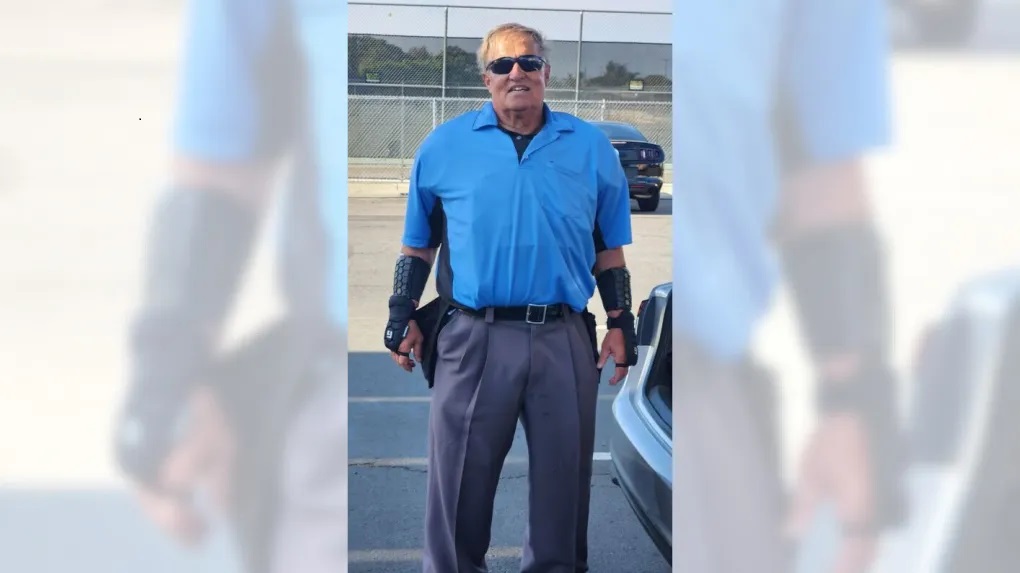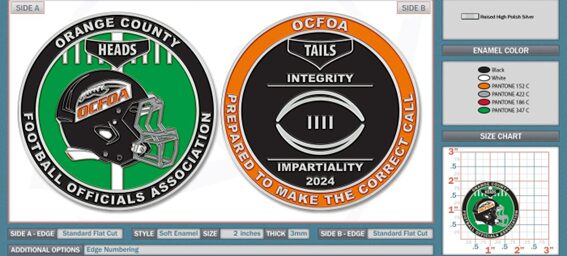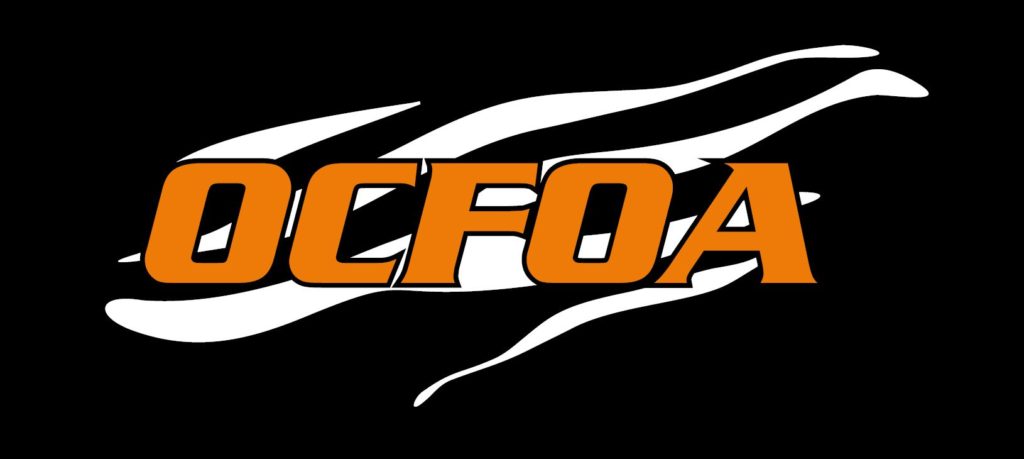Category Archives: Announcement
Jim Trentin overcame stigma of his autism to become accepted as an Orange County baseball umpire
 Another OCFOA member in the press. This time it is our very own Jim Trentin. Congratulations Jim. Happy to have you in our ranks.
Another OCFOA member in the press. This time it is our very own Jim Trentin. Congratulations Jim. Happy to have you in our ranks.
Jim Trentin overcame stigma of his autism to become accepted as an Orange County baseball umpire
New Flip/Challenge Coins have arrived

All, the new OCFOA flip/ Challenge coins have arrived.
All, the new OCFOA flip/challenge coins have arrived.
We are selling Challenge/Flip coins to the association at $5 Each. The cost of each coin is $4.22. The difference in the cost of the coin and the proceeds will be deposited in the Chad Wilson Scholarship Fund for our future officials.
If you are not aware of how a challenge coin works the lower the number, the better. Each coin has a numeric value ranging from 001 – 500 on the edge of the coin.1. Coins 1 and 2 are reserved for Association Archives.
2. 11 through 25 are reserved for Auction. 5 a year (3 years) and proceeds will go towards the scholarship fund.
3. General Association. Limit 5 per individual. First coin will be the next coin available (limit 1 under 100). then numerical
4. General Association. 2nd round after season starts and I am confident all individuals have had an opportunity to order.
Priority will go to the first email by date and time for selections.
Finally, payment can be made by Venmo to me, check or in cash during meetings. I will keep track and release coins in person ONLY. I will not mail them.
If you have any questions do not hesitate to ask.
Troy Leonard
2024 Calendar Of events as of: 5-8-2024
| Event | Date | Time | Owner | In person location | Zoom | OCFOA Instruction Credit | Comments |
| CFOA – Flag Instructional Meeting | 05/15/2024 Wed | 7:00 PM | MaryAnn Menlove | NO | Zoom Meeting | NO | |
| OCFOA – Flag Instructional meeting | 05/21/2024 Tue | 6:30 PM | Rick Langemeier | NO | Zoom Meeting | YES | |
| CFOA – Flag Instructional Meeting | 06/12/2024 Wed | 7:00 PM | MaryAnn Menlove | NO | Zoom Meeting | NO | |
| OCFOA – Flag Instructional meeting | 08/07/2024 Wed | 6:30 PM | Rick Langemeier | NO | Zoom Meeting | YES | |
| OCFOA – General Instruction Meeting (Fieild Mechanics) | 08/10/2024 Sat | 9:00 AM | Paul Caldera | Saddleback HS – 2802 S. Flower St, Santa Ana 92707 | NO | YES | Wear athletic clothing |
| OCFOA – Genearl Instruction Meeting #2 | 08/14/2024 Wed | 6:30 PM | Paul Caldera | Los Alisos Intermediate School – 25171 Moor Ave, Mission Viejo, CA 92691 | NO | YES | |
| OCFOA – Genearl Instruction Meeting #3 | 08/21/2024 Wed | 6:30 PM | Paul Caldera | Villa Park HS – 18042 Taft Ave, Orange, CA 92681 | NO | YES | |
| OCFOA – Genearl Instruction Meeting #4 | 09/04/2024 Wed | 6:30 PM | Paul Caldera | Los Alisos Intermediate School – 25171 Moor Ave, Mission Viejo, CA 92691 | NO | YES | Nominations |
| OCFOA – Flag Instructional meeting | 09/11/2024 Wed | 6:30 PM | Rick Langemeier | NO | Zoom Meeting | YES | |
| OCFOA – Board Meeting | 06/11/2024 Tue | 6:30 PM | Troy Leonard | NO | Zoom Meeting | NO | All Are Welcome to attend |
| OCFOA – Genearl Instruction Meeting #5 | 09/18/2024 Wed | 6:30 PM | Paul Caldera | Villa Park HS – 18042 Taft Ave, Orange, CA 92681 | NO | YES | Elections |
| OCFOA – Genearl Instruction Meeting #6 | 10/09/2024 Wed | 6:30 PM | Paul Caldera | Villa Park HS – 18042 Taft Ave, Orange, CA 92681 | NO | YES | |
| OCFOA – Genearl Instruction Meeting #7 (EOY) | 10/09/2024 Wed | 6:30 PM | Paul Caldera | Olde World Village Huntington Beach | NO | YES | Social Meeting End of year party |
OCFOA Crew Chief Don Ariosto in Referee Magazine
Send a congratulations to Don for making Referee magazine.
Football 2_24 page_68MaryAnn Menlove – CA State Girls Flag Rules Interpreter

Please help me in congratulating OCFOA’s very own MaryAnn MenLove in her new roles for CIF Girls Flag Football. In OCFOA She was the 2019 Rookie of the Year, officiated the 2021 CIF State Regional at Headlines and officiated NFL Flag national championships.
MaryAnn has accepted the positions of:
- CIF State Rules Interpreter for Girls Flag Football
- CFOA Girls Flag Instruction Chair
If you are interested in officiating Girls Flag Football she is a wealth of knowledge and can direct you on what is needed.
Again, Congratulations MaryAnn, thank you for your efforts.
Email:CAFlagFootball@gmail.com
Categories of Defensive Pass Interference
Ejections
 If there is an ejection of a coach or play in your game, I need to be notified by phone, text or email ASAP by the calling official.
If there is an ejection of a coach or play in your game, I need to be notified by phone, text or email ASAP by the calling official.
The calling official is required to go to the OCFOA website and fill out an ejection report. The link with instructions is http://ocfoa.org/members-area/cif-ss-incident-ejection-report/
The crew chief may want to follow up as necessary.
Paul Caldera
Liaison, CIF-SS Orange County
Assignor, Orange County Football Officials Association
orgcohsliaison@gmail.com



